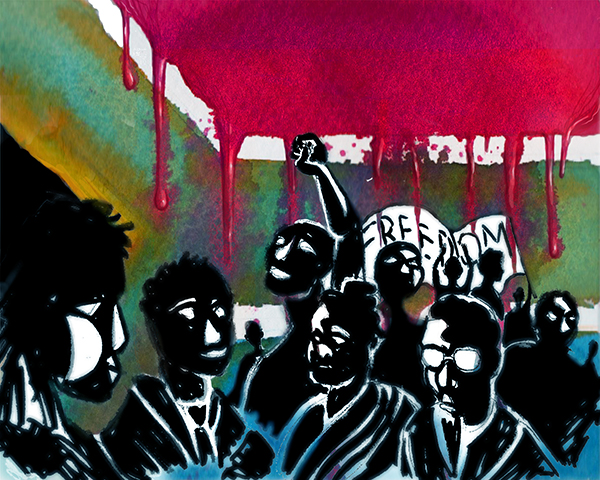Sebatana ha se bokwe ka diatla
Illustrated by ELENA VEGAS
Resistance through sabotage. These first acts of violence in apartheid South Africa were organized under the “M plan”––Mandela's plan. In the serenity of his eulogy, few of us remember Nelson Mandela as the great leader of a violent movement. Not exactly. But it was violent tactics––sabotage of government buildngs and facilities––finally used by the ANC, African National Congress, during the anti-apartheid movement in South Africa that eventually brought enough internal pressure to bring down apartheid.
 Few remember the power of violent acts that helped bring the end of Apartheid. Few want to. We can remember the 1960 Sharpeville massacre, when police opened fire on black demonstrators. But who recalls how this was the turning point for the African National Congress to switch from non-violent tactics to violent tactics against the apartheid government?
Few remember the power of violent acts that helped bring the end of Apartheid. Few want to. We can remember the 1960 Sharpeville massacre, when police opened fire on black demonstrators. But who recalls how this was the turning point for the African National Congress to switch from non-violent tactics to violent tactics against the apartheid government?
In 1960, government forces turned on protesters killing 69 and badly injuring 189. Protesters were shot in the back. Afterwards the leaders of the ANC got together, realizing something more than silent protest needed to be done. Passive resistant tactics like the “a nationwide stay-at-home” day was not as effective as the leaders of the anti-apartheid movement would have liked. People cared little that people were not going to work or walking instead of bussing around restricted zones and just ripping up their passbooks. The hope was that more active resistance could stop suppression and, in the case of Sharpeville, slaughter.
Now riots were breaking out in many areas in response to the Sharpeville massacre. The state was brought under martial law and the ANC brought their organization underground in preparation for their next tactic: violence. The ANC felt they simply had no other choice. The ANC and other groups weren’t going to just stand there while their people were being killed. It seemed to many that it was time to fight back. It’s important to understand that the ANC originally had no intensions of being violent. They started the ANC advocating for peaceful protests against repression. They only used violent forms of resistance as a very last resort.
Before this moment the black opposition had been nonviolent for nearly fifty years. Mandela attended a secret meeting of the ANC National Executive Committee with other members of the Congress movement in Durban. They discussed the kind of actions they were to take next. Mandela wanted to remain doing peaceful protests such as stay-at-homes. But Mandela also understood, and said as much in his book, that “the days of nonviolent struggle were over.” It was then decided that the ANC would direct their tactics differently. Mandela spoke to the leader of the communist party and said it was time for Sebatana ha se bokwe ka diatla, which translates as “the attacks of the wild beast cannot be averted with only bare hands.” Mandela gave him the example of Fidel Castro, who was recently victorious in his revolutionary moment in Cuba, who didn’t wait to take action. The violent struggle began because “it was wrong and immoral to subject [the] people to armed attacks by the state without offering them some kind of alternative.” The new military wing of the ANC was called Umkhonto we Sizwe, which translates into the Spear of the Nation.
Their tactics consisted of sabotaging government buildings and police meeting locations. For instance on June 14th 1986 The Spear head of the Nation also known as the MK planted a bomb on a car close to the Why Not Magoo’s Bar, a place frequently visited by police officers. Three civilians died in the process and many others were injured. There were small attacks on police officers. The Johannesburg Magistrate court bombing was another militant tactic brought on by the anti apartheid movement in order to help crumble the apartheid government. The numerous assaults on the infrastructure of South Africa, including Post offices, electrical power lines, and refineries, and the funding the ANC received from the Soviet Union and even IRA, led to the United States and Great Britain calling the ANC a terrorist group, including its leadership, Nelson Mandela. We like to remember yesterday’s rebel as today’s freedom fighter, but we must not gloss over the actions of the ANC. Their decision to employ measured violent tactics had an important place, too, in ending apartheid.

Comments
No comments posted yet.
You have to be registered and logged in in order to post comments!